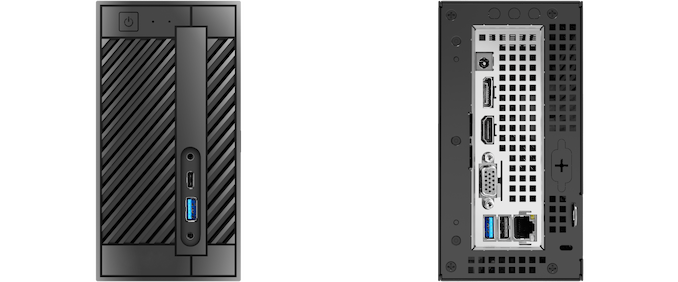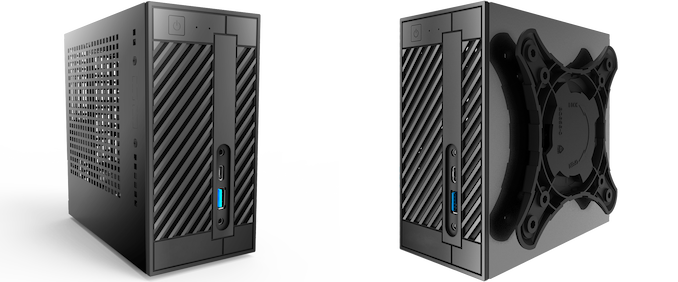The ASRock DeskMini 310 Mini-PC Review: A Cost-Effective Mini-STX Platform
by Ganesh T S on March 15, 2019 9:30 AM ESTConcluding Remarks
In this review, we were able to gather an idea of how the DeskMini 310 fares across a range of benchmarks. These cover most productivity workloads. However, two fairly important segments - gaming and performance for HTPC workloads - were not quantitatively investigated. The mini-STX form-factor is simply not amenable to the former, as the integrated GPU in the 8th and 9th Generation CPUs is not suitable for extensive gaming. For the latter, the focus on affordability has prevented ASRock from integrating a HDMI 2.0 port. The chassis is well-ventilated, but, the lack of any noise dampening means that the system is not as quiet as what one would expect from a HTPC. In any case, the Beebox series is more suitable for that market segment. The DeskMini 310 has its own target market in the business space, and it delivers a very cost-effective solution in that niche.
The mini-STX form-factor allows users to install powerful high-TDP processors in a compact, yet, flexible machine. While ASRock has premium machines with discrete GPUs in the micro-STX line (such as the DeskMini Z370 GTX), the main focus of the mini-STX suite is affordability. The H310 is a low-end chipset meant exactly for this market segment, and system vendors need to design the platform very carefully to get around its limitations. The enabling of the M.2 SSD slot with PCIe lanes directly from the CPU gets around the bandwidth constraints imposed by the PCIe 2.0 links in the H310 PCH.
It may be easy to provide ASRock with a list of needed improvements - say, a couple of USB 3.1 Gen 2 ports, or, even Thunderbolt 3. But, one also has to keep in mind that the DeskMini 310 is an entry-level product with the H310 PCH. Despite the usage of this low-end chipset, ASRock has delivered a fairly flexible barebones PC for just $162. Our only complaint about the price is that the DeskMini 110 with similar characteristics was introduced at $130 (and is still being sold in the channel at that price). In any case, the price includes the Wi-Fi module, chassis, and power supply also - aspects overlooked by DIY builders who may be able to source much cheaper mini-ITX boards. Assembling the DeskMini 310 is not as straightforward as the NUC. For example, mounting the Wi-Fi module and routing the antennae may be a time-consuming exercise for those unaccustomed to DIY builds.
ASRock's BIOS quality and feature set in the mini-PC space is perhaps surpassed only by Intel in their NUCs. The DeskMini 310 launched with support only for the 8th Gen processors from Intel. However, a BIOS updated issued last month now enables users to install 9th Gen CPUs in the unit. As mentioned earlier, the mini-STX platform appears to be geared towards long life-cycle products. So, it is satisfying to see ASRock continue to devote resources to entry-level products such as the DeskMini 310.













48 Comments
View All Comments
Motorazr - Tuesday, March 19, 2019 - link
The H310 chipset used here is kind of a dog and the case is nothing special. At a mere 3.7-liters volume, the Antec SK110-U3 case seems like a better choice and fits a B360, Z370, or Z390 chipset Mini-ITX mobo:https://pcpartpicker.com/b/Xq29TW
alicetaylor - Friday, March 22, 2019 - link
Thank you for sharing valuable information. Nice post. I enjoyed reading this post.http://catmario.games
thutrangctp - Thursday, April 4, 2019 - link
With a mini computer, the configuration is quite goodhttp://fnafgame.net
mikato - Friday, April 5, 2019 - link
Could someone explain why not having HDMI 2.0 rules out usage as an HTPC?hansara911 - Sunday, April 21, 2019 - link
Very convenient, I think many people will like and buy ithttp://basketballlegends.co
alicetaylor - Monday, May 13, 2019 - link
Your topic is very great and useful for us…thank youhttp://returnman3game.net
shafiqrehman - Monday, August 26, 2019 - link
Thanks for sharing! Appreciate your work.alicetaylor - Tuesday, February 4, 2020 - link
In the '80s and most of the' 90s, PC desktops only ... Gaming on mobile devices has surpassed that threshold, even ... There's another factor in the display that makes gaming phones ... Most models currently on the market have dual stereo speakers, the Razer Phone has ...http://strikeforceheroes3.games